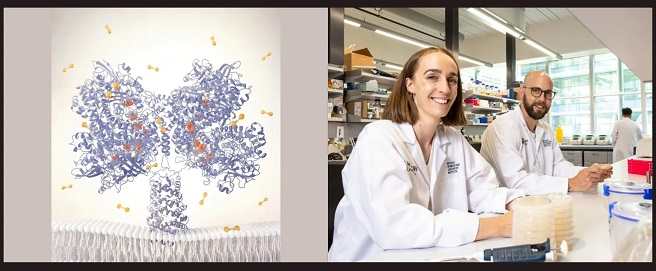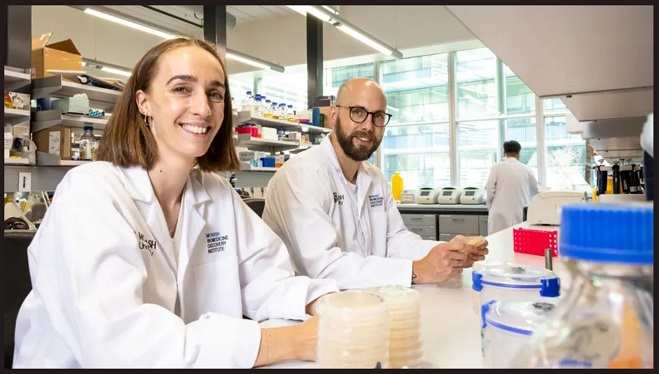This discovery opens the way to create electricity from the air, and an enzyme is responsible
Scientists from Monash University have discovered an enzyme made by bacteria that can produce electricity by using hydrogen found in the air. This enzyme is called Huc, and it has surprised the scientific community because it is a new and unusual way to generate electricity.

The discovery of Huc could have important implications for renewable energy, as it may provide a new way to generate electricity without relying on fossil fuels. However, more research is needed to understand how this process works and how can be used on a larger scale.
A group of researchers from Monash University in Australia, led by Dr. Rhys Grinter, Ph.D. student Ashleigh Kropp, and Professor Chris Greening from the Biomedicine Discovery Institute, have made a significant discovery that could change the way we generate green power in the future.
They found the potential to revolutionize the field of renewable energy and could offer a sustainable way to produce electricity without harming the environment. This exciting development is a big step forward in the search for cleaner and greener sources of energy.
The discovery of the Huc enzyme produced by bacteria has opened up new possibilities for clean energy and improved our understanding of the biochemistry of our planet. This enzyme has special qualities that allow it to use hydrogen from the air to generate electricity.
That is a new and innovative way to create energy without relying on fossil fuels or causing harm to the environment. The discovery of Huc could pave the way for further developments in the field of clean energy and help us find more sustainable ways to power our world.
What does the Huc enzyme do?
The Huc enzyme is unique because it can use hydrogen gas at levels lower than what is found in the air around us. That means that it can generate small amounts of electricity by consuming hydrogen gas from the air or an external source.
That sets the Huc enzyme apart from other enzymes and chemical catalysts, which do not have this capability. This unique ability of the Huc enzyme makes it a potential game-changer in the field of clean energy, as it may offer a new way to generate electricity without harming the environment.
The process of generating electricity from the air using bacteria is complicated, and until now, scientists did not know how it worked. However, the research team from Monash University has made progress in this area by isolating the Huc enzyme from a bacterium called Mycobacterium smegmatis.
This bacterium is commonly found in soil, does not cause disease, and studied extensively. By studying the Huc enzyme, researchers hope to understand how it generates electricity and how this process can be harnessed for sustainable energy production.
It has been known for some time that bacteria can use small amounts of hydrogen found in the air as a source of energy. However, the scientific community did not understand the process of how this happened.
Professor Chris Greening from Monash University explains that the discovery of the Huc enzyme has shed light on this mystery. Now, researchers have a better understanding of how bacteria can use hydrogen from the air to generate electricity. This new knowledge could help us develop more sustainable ways to produce energy in the future.
The research team from Monash University discovered something surprising about the Huc enzyme – it has an additional component that was previously unknown. This component is crucial to the formation of a large complex, which is important for how Huc functions within cells.

When the researchers removed this component, Huc was no longer able to form the large complex. This discovery highlights the complexity of the Huc enzyme and how much there is still to learn about how it works.
The more we understand about the Huc enzyme and its functions, the better we can utilize its potential for sustainable energy production.
The research team also found that the purified Huc enzyme can be stored for long periods without losing its ability to generate energy. It was discovered that the enzyme is highly stable and can be frozen or heated to high temperatures without losing its effectiveness.
This characteristic of Huc reflects how it helps bacteria survive in harsh environments. This stability and resilience make the Huc enzyme a promising candidate for use in sustainable energy production, as it can be easily stored and utilized in a range of conditions.
Diverse applications
While there is still much to learn and research before the discovery of the Huc enzyme can be applied effectively, the potential for its use is promising and diverse. The Huc enzyme offers a new way to generate clean energy from the air and maybe a key component in developing sustainable energy sources for the future.
Its stability and ability to function in extreme environments also make it a potential candidate for use in a wide range of applications beyond energy production. However, it will require further research and development before the full potential of Huc can be realized.
For example, Huc is extremely sensitive to hydrogen, which would allow for precise measurements and makes it ideal for use as a hydrogen detector.
One of the most promising applications of the Huc enzyme is its ability to generate energy for small electronic devices with just the presence of air or low concentrations of energy. That means potentially be used to power small devices without the need for traditional batteries or power sources.
Additionally, the large-scale production of clean energy is also possible by adding green hydrogen in large quantities. Green hydrogen is a sustainable energy source that is currently being heavily invested in and developed. With the help of the Huc enzyme, it may be possible to produce clean energy on a large scale and help to reduce our reliance on fossil fuels. However, more research and development will be needed to make this a reality.
Dr. Grinter believes that once Huc is produced in sufficient quantities, its potential for use in clean energy production will be “limitless.” The Huc enzyme represents a significant breakthrough in the field of sustainable energy production, as it offers a new way to generate electricity from the air using hydrogen gas. If it can be produced on a large scale, it could be a game-changer in our efforts to reduce our reliance on fossil fuels.
In addition to its potential applications in energy production, research on Huc can also help us better understand the workings of our planet. Between 60% and 80% of the bacteria present in soils, particularly nutrient-deprived soils, have enzymes similar to Huc and are constantly absorbing hydrogen.
By studying these enzymes and their functions, we can gain insights into how our planet’s biochemistry works, which could have implications for a range of fields, from agriculture to environmental science.
The bacteria have enzymes similar to Huc are absorbing 70 million tons of hydrogen from the atmosphere each year. This process helps shape the composition of our atmosphere, which is important in regulating our planet’s climate. Understanding the biochemistry behind this process may provide us with valuable insights into how we can stabilize our climate in the future.
Dr. Grinter believes that studying the Huc enzyme and its functions can help us better understand and manage climate change. By learning how bacteria use hydrogen from the air to generate energy, we can develop new technologies and strategies to reduce our carbon footprint and mitigate the effects of climate change.
Therefore, research on the Huc enzyme not only has implications for clean energy production but also for addressing one of the biggest challenges of our time, which is climate change.
Related Post
- Volkswagen increases its investments in electrification and digitization to ($ 129,940000) 122000 million euros
- 2023 Toyota Prius specifications are More Relevant and appealing (interior, Cargo, Space)
- What you have to do to prevent your electric car from having problems with the brakes
- Toyota Completes First Tests Running on Liquid Hydrogen
